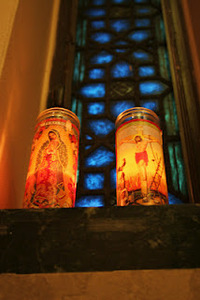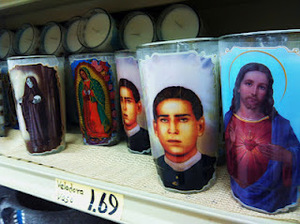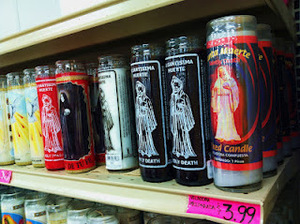By Juan Miret
A Hispanic Matter

Lighting a candle or a votive candle is not a casual or even trivial event. We do so often, just as our ancestors did – to dispel the darkness with that tiny flame, which issues a kind of mystical aura.
Perhaps because of their aesthetic sense and a kind of immediate connection to the past, candles and votive candles are for Hispanics – Catholics or not – a symbol of affection, meditation or devotion.
“In my house we always have to have a votive candle for the Virgin of Guadalupe,” said Graciela Naranjo, 68, a native of Piedras Negras in the Mexican state of Coahuila, who was making her usual purchase in a natural products store in Plaza Santa Cecilia, east of Tulsa. “Yet I also like the candles for St. Anthony to see if my granddaughters will each find a good boy.”
According to Naranjo, the candles “light the way,” but one must have much faith. “St. Anthony and St. Jude always help, but you have to indulge them with candles.”

Simon Navarro, a native of Guanajuato, Mexico, and owner of the store, sells a variety of candles. “Immigrants need to maintain their traditions and sometimes something as simple as a candle helps,” he said while holding an image of the baby Jesus Healer of the Sick. “This for example is a very ancient custom from Puebla.”
For María Concepción Duarte, 48, who is from Zacatecas, Mexico, May is the month of candles. “I remember my mother lit a candle every day in May,” she said as she chose a pair of candles in a market on the city’s east side. “That little flickering light makes me think a lot about her.”
Candles with images of the Virgen Morena or Virgin of Guadalupe, St. Toribio Romo and the Sacred Heart of Jesus, are mixed in with other candles, known as “prepared” candles, such as a black one dedicated to Saint Death.

“It is not witchcraft,” said Argenis Sandoval, who works at a Hispanic market in southwest Tulsa. “The Santa Muerte gives money, luck and even love. What has happened is that she is followed a lot by the drug traffickers in Mexico and that’s why some people do not like it.”
Claudia Maldonado, 51, originally from Mexico City, has a different view. “I don’t like them having Saint Death close to the other votive candles,” she said as she carried one for Santo Toribio, considered the patron saint of immigrants. “I do not like it.”
Candles are part of the church, especially in their rituals. “That’s why the candles must have images that are respected, that are symbols of goodness,” said Maldonado. “What I love about the votive candles is that you can have a little altar in the house.”
Candles and votive candles serve as a kind of lantern to remind immigrants of the road they have traveled since they left their homelands in search of a better fate.




